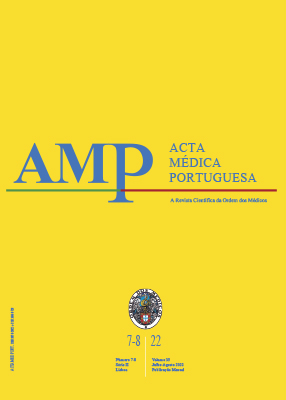Anisakis Allergy: Raising Awareness
DOI:
https://doi.org/10.20344/amp.15908Keywords:
Anaphylaxis, Anisakiasis, Anisakis, Food Hypersensitivity, Hypersensitivity, UrticariaAbstract
Introduction: Ingestion of Anisakis is a common cause of allergic reactions to seafood in countries in which undercooked/raw seafood is part of gastronomic traditions. Despite current trends for the ingestion of raw/marinated/undercooked fish, the prevalence rate of anisakiasis and allergy to Anisakis is still considered to be low in Portugal. We aimed to review the current pathogenic mechanisms, the clinical and diagnostic approach of Anisakis allergy, and Anisakis-related eviction measures, while raising awareness to this problem.
Material and Methods: Literature search in the MEDLINE and Scopus databases, regarding Anisakis allergy.
Conclusion: Assessment of sensitization to Anisakis should be included in the workup study of urticaria/angioedema and anaphylaxis, as there is a rise in consumption of raw and undercooked fish. Ingestion of previously frozen and properly cooked fish appears to be safe for most patients who are allergic to Anisakis.
Downloads
Downloads
Published
How to Cite
Issue
Section
License
Copyright (c) 2022 Acta Médica Portuguesa - Ordem dos Médicos

This work is licensed under a Creative Commons Attribution-NonCommercial 4.0 International License.
All the articles published in the AMP are open access and comply with the requirements of funding agencies or academic institutions. The AMP is governed by the terms of the Creative Commons ‘Attribution – Non-Commercial Use - (CC-BY-NC)’ license, regarding the use by third parties.
It is the author’s responsibility to obtain approval for the reproduction of figures, tables, etc. from other publications.
Upon acceptance of an article for publication, the authors will be asked to complete the ICMJE “Copyright Liability and Copyright Sharing Statement “(http://www.actamedicaportuguesa.com/info/AMP-NormasPublicacao.pdf) and the “Declaration of Potential Conflicts of Interest” (http:// www.icmje.org/conflicts-of-interest). An e-mail will be sent to the corresponding author to acknowledge receipt of the manuscript.
After publication, the authors are authorised to make their articles available in repositories of their institutions of origin, as long as they always mention where they were published and according to the Creative Commons license.









